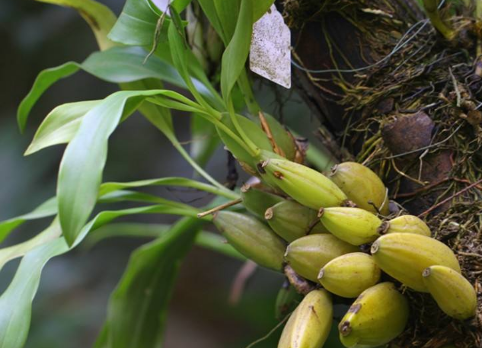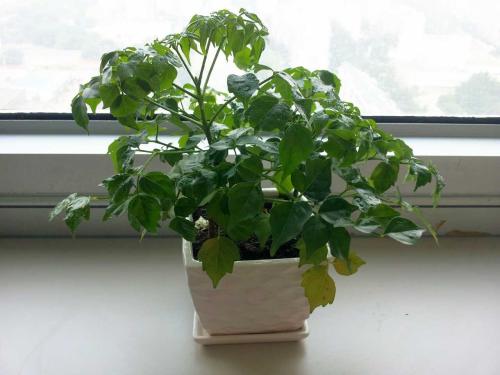Aseptic seeding and tissue Culture of Cartland
Fruit cultivation
The mother plants with better growth were selected for self-pollination and cross during flowering, and the mature fruit could be produced 4-5 months after pollination.
Aseptic sowing
Select the ripe fruit, soak it in 75% alcohol for half a minute, soak it in 0.1% mercury solution for 20 minutes, rinse it with sterile water for 4 or 5 times, then cut the fruit, inoculate the white powdery seeds in the liquid medium, and shake the culture in 150rpm shaker. The germ germinated after a week, and the green protocorm was formed in 20 days.

Culture and seedling
The protocorm was planted with a straw and cultured on the seedling medium, and it could become a complete plantlet after one month.
Test tube transplanting
When the seedlings grow to 3-4 cm high, move them to natural light for 1-2 weeks, allowing the plants to form a stratum corneum. Wash the root culture medium and mix it into the substrate for normal culture.
The price of Cartland
Cartland evergreen, pseudoscale is club-shaped or cylindrical, pseudobulb is fusiform, plant height is more than 25 cm; a stem has 2 to 3 leaves, leaves thick and long ovate. Usually bloom once in autumn, some can blossom twice, and there are different varieties blooming in all seasons of the year. Pedicel 20 cm long, there are 5 to 10 flowers, large flowers, flower diameter of about 10 cm, with a special aroma, each flower can bloom continuously for a long time; in addition to black, blue, almost all colors, beautiful, has the title of "king of orchids".
Cartland cultivation can be divided into single-leaf species and double-leaf species. Propagation should be done by plant division, tissue culture or aseptic sowing. The winter temperature is 15: 20 ℃. It blossoms once or twice a year, and the flowering period is generally about 3-4 weeks.
Cartland is a perennial herb, belonging to epiphytic orchid, evergreen all the year round. The plant has 1-3 leathery thick leaves, which is the tissue for storing water and nutrients.
Can use 6 pieces of broken fern root, 1 part of vermiculite, plus charcoal and gravel and so on. Transplanting is best carried out after the end of dormancy.
A brief introduction to Cartland
Cartland is a horticultural hybrid and is one of the most famous orchids in the world. The pseudobulb is clavate or cylindrical, with 1 or 3 leaves at the top; the leaves are thick and hard, the midvein is concave; the flowers are single or several, born at the top of the pseudobulb, and the flowers are large and beautiful, bright and rich in color. Native to tropical America, it is the national flower of Brazil, Argentina, Colombia and other countries.
There are more than thousands of varieties. The colors are white, yellow, green, red and purple and so on. Propagation should be done by plant division, tissue culture or aseptic sowing. Sex likes warmth, moisture and plenty of light. Potted plants such as fern roots, moss and bark are usually used. High air humidity, proper fertilization and ventilation are needed during the growth period.
Cartland's flowers are large, elegant and gorgeous, the flowers are delicate and varied, and the flowers are fragrant and fragrant. In the world, they are known as "king of orchids" and "queen of orchids".
There are 3 sepals at apex, extending vertically as the greatest feature of this flower.
Cartland has not been cultivated in China for a long time, and the large-scale production is still after the 1980s. But it enjoys a high position in the flower market. It is very popular with the citizens. It has become one of the important flowers for relatives and friends on a festive day.
- Prev

Ramet propagation of Cartland
Cartland is usually selected and propagated, usually in the spring and autumn rainy season. The rhizome at the base of the rhizome can be carefully cut with a knife, and each clump should have 2 false bulbs with new buds.
- Next

The breeding mode of happiness tree
1. Cuttings take the qualitative branches of Happy trees, cut all the leaves, insert them into the soil, and then take good care of them every day until they take root. 2. the strip cuts the branch near the ground, then presses it into the soil, and finally, after the cut grows out of the root system.
Related
- Fuxing push coffee new agricultural production and marketing class: lack of small-scale processing plants
- Jujube rice field leisure farm deep ploughing Yilan for five years to create a space for organic food and play
- Nongyu Farm-A trial of organic papaya for brave women with advanced technology
- Four points for attention in the prevention and control of diseases and insect pests of edible fungi
- How to add nutrient solution to Edible Fungi
- Is there any good way to control edible fungus mites?
- Open Inoculation Technology of Edible Fungi
- Is there any clever way to use fertilizer for edible fungus in winter?
- What agents are used to kill the pathogens of edible fungi in the mushroom shed?
- Rapid drying of Edible Fungi

